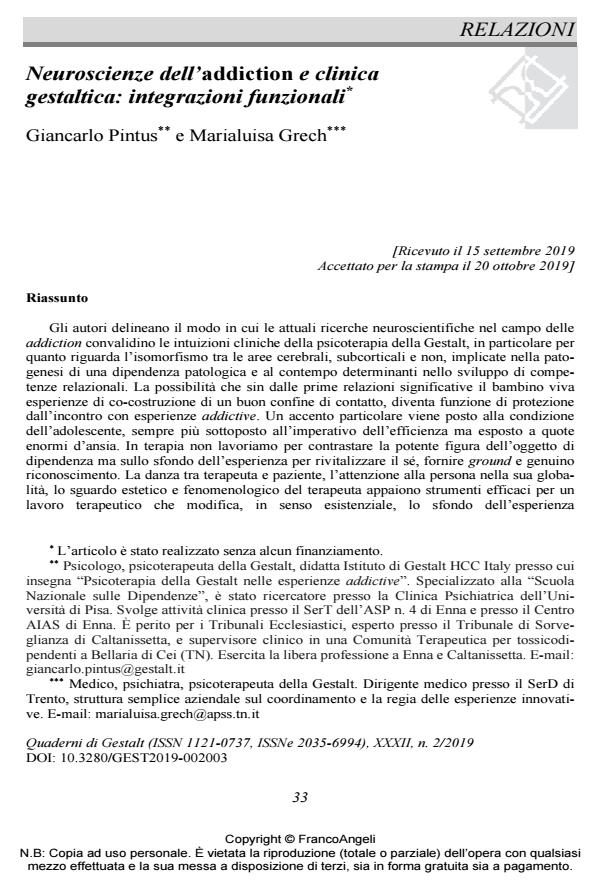Neurosciences of Addiction and Gestalt Clinical Practice: Functional Integrations
Journal title QUADERNI DI GESTALT
Author/s Giancarlo Pintus, Marialuisa Grech
Publishing Year 2020 Issue 2019/2
Language Italian Pages 17 P. 33-49 File size 219 KB
DOI 10.3280/GEST2019-002003
DOI is like a bar code for intellectual property: to have more infomation
click here
Below, you can see the article first page
If you want to buy this article in PDF format, you can do it, following the instructions to buy download credits

FrancoAngeli is member of Publishers International Linking Association, Inc (PILA), a not-for-profit association which run the CrossRef service enabling links to and from online scholarly content.
The authors describe the relationship between recent neuroscientific researches on addic-tion (cfr. Robinson e Berridge, 1993; Leshner, 1997; Volkow e Fowler, 2000; Goldstein, 2001; Goldstein e Volkow 2002; Gessa, 2003; McFarland et al., 2003; Pulvirenti, 2007; Bri-colo et al., 2010) and clinical insights of Gestalt therapy on this topic; in particular they refer to isomorphism of some brain areas (subcortical and superior) involved both in the addiction pathogenesis and in the development of relational skills. The authors describe Perls’ reflec-tions (1995) on “hanging on bite”, the recent reflections of other Gestalt authors (Pintus e Crolle Santi, 2014; Pintus, 2015; 2016; 2017) on the dependent relationship style, the value of the first parent-child relationships as an opportunity for relational and cerebral attunement and describe the processes and areas of the brains involved in these phenomena. The addiction de-velopment is an experience of persistent background trauma, a dissociation between cognitive and emotional brain areas. If the child feels supported in the first significant relationships to live a spontaneous contact boundary then a good attunement and recognition are created. On the contrary the relational detuning causes less development of the mesolimbic area and deficit in the decoding of emotions. These children could develop a specific vulnerability to become fragile and insecure adults. The authors emphasize the adolescent condition: he is pushed more and more towards efficiency but often he feels enormous anxiety. The desensitization, caused by substances, is often an opportunity for the adolescent who, confused between who he was and who he would like to be, finds a label for his pain. The Gestalt therapist does not work against the addiction powerful figure, he works with the background experience of the client: in pathological dependences the obsession for the loved object becomes so intense, so capable of nullifying the background experience, that in therapy it is necessary to work creatively to revitalize it. Therefore the main therapy goal is not abstinence but to revitalize the self, provide basic and genuine recognition. The living and real presence of a significant Other on the contact boundary can become an opportunity for the ad-dict to reconstruct his dysfunctional attachment tale; unlike an object, immovable and immuta-ble, the living presence of the therapist can become an opportunity to realize the intentionality of interrupted contact. Concepts such as contact boundary, situational field, aesthetic relational knowledge (Spagnuolo Lobb, 2015) represent a possible bridge towards neuroscience, partic-ularly for understanding the mind, the brain and the relational styles of an addictive client. The dance between therapist and client (Spagnuolo Lobb, 2017), attention to the person as a whole, the aesthetic and phenomenological gaze of the therapist (Spagnuolo Lobb, 2012; 2015) are effective tools for a Gestalt therapeutic work. These tools modify, in an existential way, the background of the experience of the addicted person in the relationship with himself and the world; but they are able, in a neurophysiological sense, also to activate a new integration be-tween cognitive and emotional areas of the brain that had been disconnected from the trauma of addiction.
Keywords: Addiction, neuroscience, adolescence, vulnerability, recognition experience.
Giancarlo Pintus, Marialuisa Grech, Neuroscienze dell’addiction e clinica gestaltica: integrazioni funzionali in "QUADERNI DI GESTALT" 2/2019, pp 33-49, DOI: 10.3280/GEST2019-002003